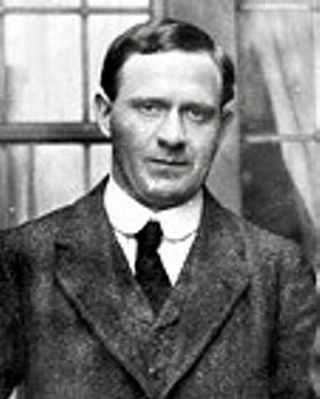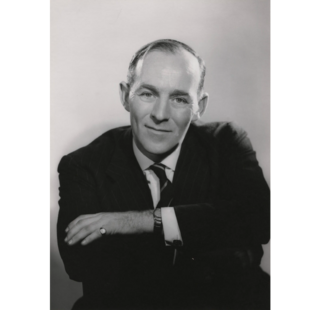
The history of Antarctica emerges from early Western theories of a vast continent, known as Terra Australis, believed to exist in the far south of the globe. The term Antarctic, referring to the opposite of the Arctic Circle, was coined by Marinus of Tyre in the 2nd century AD.

Sir Vivian Ernest Fuchs was an English scientist-explorer and expedition organizer. He led the Commonwealth Trans-Antarctic Expedition which reached the South Pole overland in 1958.

Louis Charles Bernacchi was an Australian physicist and astronomer best known for his role in several Antarctic expeditions.

Operation Tabarin was the code name for a secret British expedition to the Antarctic during World War Two, operational 1943–46. Conducted by the Admiralty on behalf of the Colonial Office, its primary objective was to strengthen British claims to sovereignty of the British territory of the Falkland Islands Dependencies (FID), to which Argentina and Chile had made counter claims since the outbreak of war. This was done by establishing permanently occupied bases, carrying out administrative activities such as postal services and undertaking scientific research. The meteorological observations made aided Allied shipping in the South Atlantic Ocean.

The Ross Sea party was a component of Sir Ernest Shackleton's 1914–1917 Imperial Trans-Antarctic Expedition. Its task was to lay a series of supply depots across the Great Ice Barrier from the Ross Sea to the Beardmore Glacier, along the polar route established by earlier Antarctic expeditions. The expedition's main party, under Shackleton, was to land near Vahsel Bay on the Weddell Sea on the opposite coast of Antarctica, and to march across the continent via the South Pole to the Ross Sea. As the main party would be unable to carry sufficient fuel and supplies for the whole distance, their survival depended on the Ross Sea party setting up supply depots, which would cover the final quarter of their journey.

James William Slessor Marr was a Scottish marine biologist and polar explorer. He was leader of the World War 2 British Antarctic Expedition Operation Tabarin during its first year, 1943–1945.

David Pelham Guthrie-James, MBE, DSC was a British Conservative Party politician, author and adventurer.

Sir James Mann WordieCBE FRS FRSGS LLD was a Scottish polar explorer and geologist. Friends knew him as Jock Wordie.
The British Antarctic Survey (BAS) is the United Kingdom's national polar research institute. It has a dual purpose, to conduct polar science, enabling better understanding of global issues, and to provide an active presence in the Antarctic on behalf of the UK. It is part of the Natural Environment Research Council (NERC). With over 400 staff, BAS takes an active role in Antarctic affairs, operating five research stations, one ship and five aircraft in both polar regions, as well as addressing key global and regional issues. This involves joint research projects with over 40 UK universities and more than 120 national and international collaborations.

Francis Howard Bickerton was an English treasure hunter, Antarctic explorer, soldier, aeronaut, entrepreneur, big-game hunter and movie-maker. He not only made a major contribution to the Australasian Antarctic Expedition of 1911–1914 but was also recruited for Sir Ernest Shackleton's "Endurance" Expedition; he fought with the infantry, the Royal Flying Corps and the Royal Air Force in both world wars and was wounded on no fewer than four separate occasions. According to his obituary in The Times, "His loyalty to his friends, his gallantry... and the unembittered courage with which he continued to meet the difficulties of a world which gave little recognition in peace to men of his mould – leave to us who shared in one way or another his various life the memory of a rich, rewarding and abiding spirit".

James Edward Butler Futtit Farrington was a key member of a secret wartime Antarctic expeditionary force and the last surviving holder of the Polar Medal in Bronze, abolished after 1941.

John Riddoch Rymill was an Australian polar explorer, who had the rare second clasp added to his Polar Medal.

The drift of the Antarctic exploration vessel SY Aurora was an ordeal which lasted 312 days, affecting the Ross Sea party of Sir Ernest Shackleton's Imperial Trans-Antarctic Expedition, 1914–1917. It began when the ship broke loose from its anchorage in McMurdo Sound in May 1915, during a gale. Caught in heavy pack ice and unable to manoeuvre, Aurora, with eighteen men aboard, was carried into the open waters of the Ross Sea and Southern Ocean, leaving ten men stranded ashore with meagre provisions.

Commander Joseph Russell Stenhouse, DSO, OBE, DSC, RD, RNR (1887–1941) was a Scottish-born seaman, Royal Navy Officer and Antarctic navigator, who commanded the expedition vessel SY Aurora during her 283-day drift in the ice while on service with the Ross Sea Party component of Sir Ernest Shackleton's Imperial Trans-Antarctic Expedition in 1914–17. After Aurora's escape from the ice he brought her safely to New Zealand, but was thereafter replaced as the vessel's commander. He later served with distinction in the Royal Navy during both World Wars.

RRS William Scoresby was British Royal Research Ship built for operations in Antarctic waters. Specially built for the Discovery Committee by Cook, Welton & Gemmell of Beverley, the ship was launched on 31 December 1925, and named after the noted 19th-century Arctic explorer, scientist and clergyman. Over the next 12 years the ship made seven voyages into Antarctic waters as part of the Discovery Investigations, accompanied by the ship Discovery until 1929, and then by Discovery II. During this time she marked about 3,000 whales and completed biological, hydrographical and oceanographic studies. She also took part in the 2nd Wilkins-Hearst Antarctic Expedition in 1929-1930, launching a Lockheed Vega floatplane for flights over Antarctica.
Gravenoire Rock is a small rock outcrop about 1 nautical mile (2 km) southeast of Rock X, protruding above the coastal ice at the east side of Victor Bay, Antarctica. It was photographed from the air by U.S. Navy Operation Highjump, 1946–1947, was charted by the French Antarctic Expedition, 1952–1953, and so named by them because of its resemblance to Gravenoire, the name of a puy or dome-shaped hill overlooking the city of Clermont-Ferrand, which lies in the chain of extinct volcanoes forming the Monts d'Auvergne of central France.

Brian Birley Roberts was a British polar expert, ornithologist and diplomat who played a key role in the development of the Antarctic Treaty System. A biography of Roberts has been published.

Elke Mackenzie, born Ivan Mackenzie Lamb, was a British polar explorer and botanist who specialised in the field of lichenology.

International competition extended to the continent of Antarctica during the World War II era, though the region saw no combat. During the prelude to war, Nazi Germany organised the 1938 Third German Antarctic Expedition to preempt Norway's claim to Queen Maud Land. The expedition served as the basis for a new German claim, called New Swabia. A year later, the United States Antarctic Service Expedition established two bases, which operated for two years before being abandoned. Responding to these encroachments, and taking advantage of Europe's wartime turmoil, the nearby nations of Chile and Argentina made their own claims. In 1940 Chile proclaimed the Chilean Antarctic Territory in areas already claimed by Britain, while Argentina proclaimed Argentine Antarctica in 1943 in an overlapping area.
















